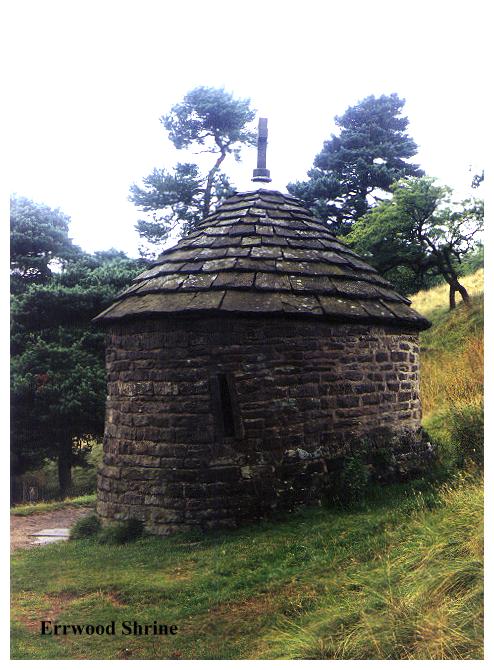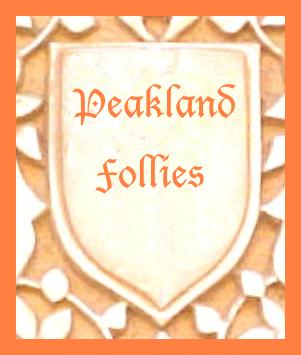7. THE GOYT VALLEY SHRINE
A magnificent (and well frequented) moorland ridge walk leading to pleasant woodlands, a ruined mansion and a curious and charming religious shrine.
Getting There: Take B5470 (Whalley Bridge- Macclesfield) road to Kettleshulme. At Kettleshulme turn left onto a small lane by the school. This road passes beneath Windgather Rocks, and leads onward to a T junction with the Goyt Valley/Jenkin Chapel road, just below Pym Chair. Just before reaching the junction, a rough carpark appears on the left, This is the start of the walk.
Distance:Four miles approx.
Map ref: Landranger Sheet 118 SJ 995 768
Rating: Walk *** Follies and General Interest ***

Pym Chair is the first objective of this walk. At the road Junction beyond the car park, turn left, and follow the lane to the summit of the pass at Pym Chair. This lane, which having crossed the ridge here at Pym Chair, descends into the Goyt Valley, follows the line of the old Roman road known as The Street. Here at the summit we are at 1547 feet above sea level, the highest point on any Roman road in Britain. Local legend informs us that Pym was a local highwayman wont to lie in wait at this bleak spot to rob unsuspecting travellers on their way up from Buxton. From Pym Chair pass through the stile (right) onto Withinleach Moor, following the well signed and waymarked path, which leads along the ridge above Cats Tor, following the line of a drystone wall. The path proceeds without complication to the triangulation pillar and junction of paths on Shining Tor, with fine views westwards all the way. Shining Tor is one of Peakland's most famous summits, lying as it does on the well trodden path to the Cat and Fiddle. It stands at an altitude of 1833 feet with (weather permitting) sweeping views out over the Cheshire Plain.
From Shining Tor the path bears left, descending alongside a wall (right) to a stile. Pass over the stile and turn left, proceeding (with the wall now on your left) along the well defined track towards Errwood Reservoir, with fine views over the Goyt Valley.
The Goyt Valley in mediaeval times formed the boundary between the Royal 'Forest' of The Peak to the east and Macclesfield Forest to the west. These were not 'forests' in the modern sense, but rather large tracts of wild and desolate country set aside as private hunting 'reserves' for the Norman conquerors of England and their descendents. In later times the valley was given over to quarrying and coalmining, one of the quarries (Goytsclough) being worked by the family later to find fame as the Pickford's Removal Company. In the 19th century the coalmines were supplemented by a paintworks and a gunpowder factory! Happily little trace of these now remain, the gunpowder manufactory being long lost beneath the tranquil waters of Fernilee Reservoir.
Errwood Reservoir was opened in 1967 to act as a supplement to Fernilee Reservoir to the north. It cost 1 million pounds to construct. Both reservoirs, now owned by North West Water, supply Stockport with water to the tune of 7 to 8 million gallons of water a day. On the east bank of the reservoir there is sailing club.
Before descending to Errwood Reservoir, a gate appears in the wall to the left, and a rough track doubles back to the left, descending into the wooded dell of Shooter's Clough. The track zigzags right, then left again, before reaching the stream in the bottom of the clough. Cross the stream, then follow the path round to the right, This soon leads along a wallside to meet the track coming up from Errwood, by a gate and a ruin. Turn right, and then a short distance down the track, which descends into woods, pass left through a gate to follow a grassy track which leads through rhodedendrons and undergrowth to the ruins or Errwood Hall.
Errwood Hall, now a sad ruin lost in rhodedendrons, was built by Samuel Grimshawe, as a wedding present for his son, Samuel Dominic Grimshawe. His estates covered almost 500 acres. The Hall, an italianate building with turrets and a tower, was built in 1830. Around it the Grimshawes planted 40,000 rhodedendron and azalea bushes. The Grimshawes were a devoutly Catholic family who lived in oriental splendour and employed their own resident priest, the last priest to officiate at Errwood being a Father Grimes.
Mary Gosselin, Grandaughter of the Samuel Grimshawe who built the hall was the last of the family to live there. When she died in 1930, it was sold to Stockport Corporation, who used it as a youth hostel until it was finally pulled down in 1934 when Fernilee reservoir was under construction. In those days, buildings in catchment areas were thought to pose a potential threat to the purity of the water. Consequently Errwood Hall, along with a watermill, a school and several cottages were demolished. Today they would not have been. The site of Errwood Hall is reputed to be haunted, and visiting there on a dank, depressing & mizzly day (as I did!) it is not too hard to imagine some shapeless apparition peering through shattered and sightless windows. The place gives you the creeps!
From Errwood Hall return to the main track, bear right and retrace your steps back to the gate and ruin where you came in from Shooter's Clough. From here a short diversion right, up into a plantation leads to the Errwood Private Cemetery.
The private cemetery is entered through an avenue of yew trees. It is the last resting place of the Grimshawe family and also of Captain John Butler, Master of the Mariquita, which was the Grimshawe's private ocean-going yacht.
From the cemetery retrace your steps to the ruin, then, bear right a short distance along the track, then right again, following a well defined path which leads to a junction of paths by a footbridge over a small stream. Beyond the footbridge, bear left uphill passing beneath Foxlow Edge, with stream and conifers below on the left. Soon the Goyt Valley Shrine appears in a little hollow on the left.

This tiny, lovely shrine is dedicated to St. Joseph. It was built in 1889 in memory of Miss Dolores de Bergrin, a spanish lady who taught at the private school owned by the Grimshawes, and who was a great friend of the family. The unfortunate lady died whilst on a pilgrimage to Lourdes. This tiny, beehive shaped building has two narrow windows and a low doorway. One expects to find the door locked and nothing inside, but the door is not locked and inside is a riot of colour, sentiment and charm. People bring meadow flowers in jamjars, prayers printed on scraps of paper, religious postcards, plastic figurines of saints, and all manner of trinkets and small items of spiritual sentiment. The altarpiece in this lovely little shrine is a representation of St. Joseph holding the Christ child, executed in tiles, above which an inscription (in Spanish) reads:- "No one asks in vain of St. Joseph. A token of gratitude.". The initials of Dolores De Bergrin are over the shrine. The wonder is that it has not been vandalised and remains an oasis of tranquility and a place for rest and meditation. Perhaps its location, twixt pine forest and moors some distance away from any road ensures its survival. But then again- maybe St. Joseph watches over it!
Beyond the shrine, the footpath enters the lane to Bollington by a wire fence. Cross the tarmac and bear left. The path runs along a grassy corridor at the side of the road, which, although muddy in parts, is easier on the feet and eliminates the need to dodge oncoming cars. From here we simply follow the 'The Street' back to the start of our walk at Pym Chair and then (assuming we haven't been asked to 'stand and deliver!') retrace our steps back to the carpark.








